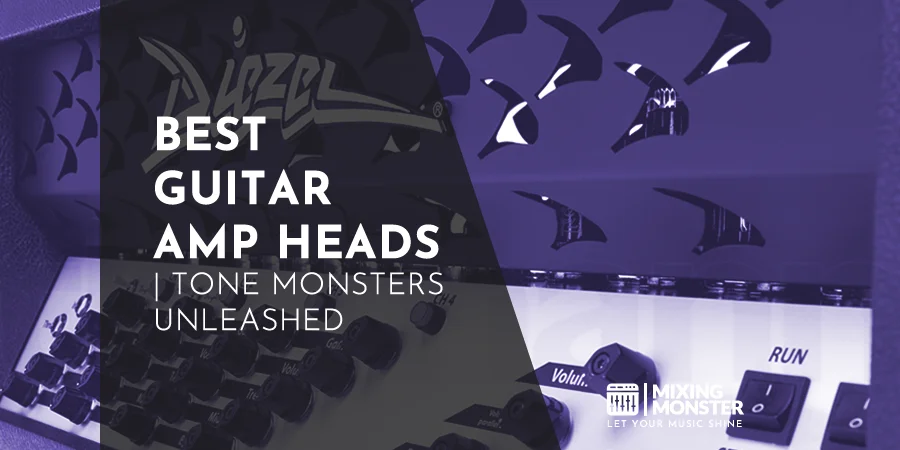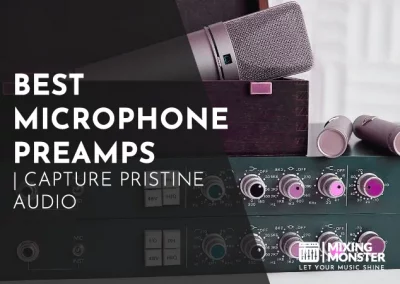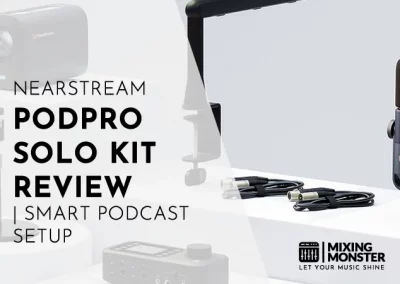Home > Blog > Studio Gear > Music Gear
Disclosure: Some of the links below are affiliate links, meaning that at no additional cost to you, we will receive a commission if you click through and make a purchase. Read our full affiliate disclosure here.
Guitar amp heads deliver the core sound and power that really shape your electric guitar’s vibe. These separate amplifier units give musicians more flexibility and customization than your typical combo amplifiers.
Guitar amp heads contain the preamp and power amp circuits but do not include built-in speakers; therefore, a connection to a separate speaker cabinet is required. This design allows players to mix and match different head and cabinet combinations to achieve their desired sound. Amp heads range from low-wattage tube models perfect for home recording to high-powered solid-state units capable of filling large venues. They come in various styles, including vintage-inspired tube designs, modern digital modeling units, and hybrid combinations that blend analog and digital technologies.
When selecting a guitar amp head, wattage, tube vs. solid-state, and channel count are the key factors to consider. Wattage controls how loud you can get (and how much clean headroom you have), while tube amps bring that warm, touch-sensitive magic that solid-state can’t quite match—though solid-state options are usually more consistent and dependable.
We examined dozens of amp heads across various price points and power levels, seeking those that truly excel in tone, reliability, and value for all types of guitarists.
KEYNOTES:
- In this article, you’ll find a comprehensive list of the best guitar amp heads on the market.
- Guitar amp heads are categorized into 4 sections:
Best Budget Guitar Amp Heads
Best Midrange Guitar Amp Heads
Best High-End Guitar Amp Heads
Best Iconic Guitar Amp Heads - Each section contains:
3-6 Guitar Amp Heads
ordered by price (low > high)
Our Top Picks – Best Guitar Amp Heads
Best Budget
Orange
Dual Terror
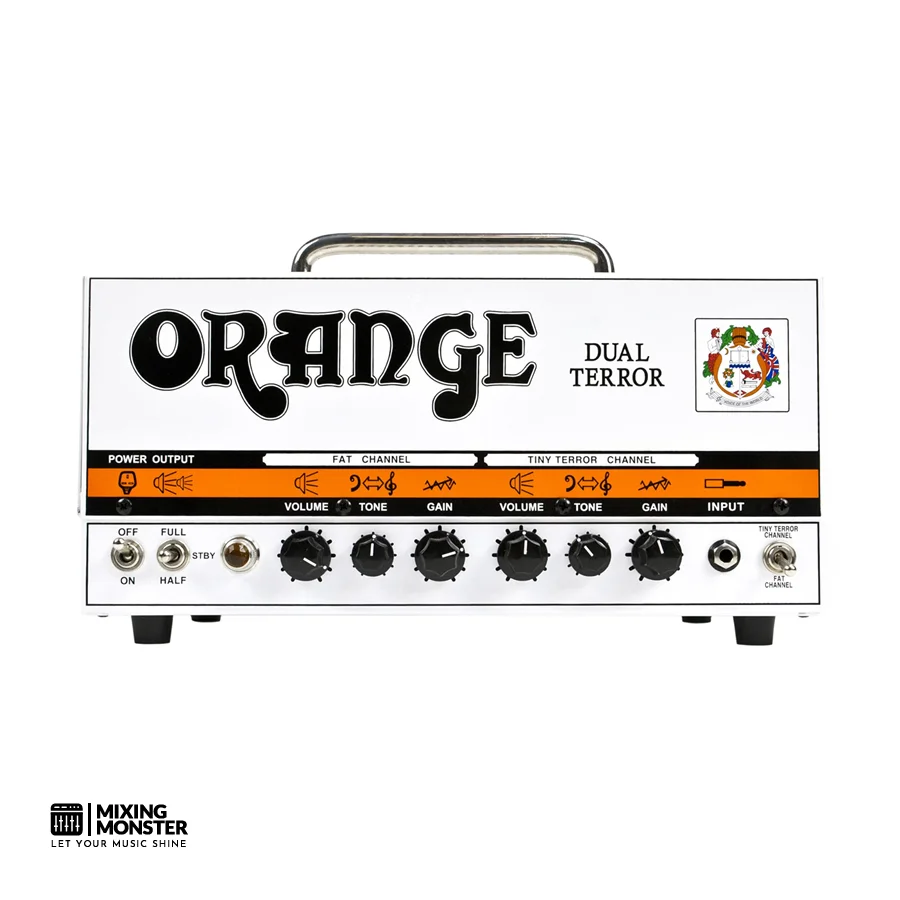
Best Midrange
ENGL
Fireball 100 E635
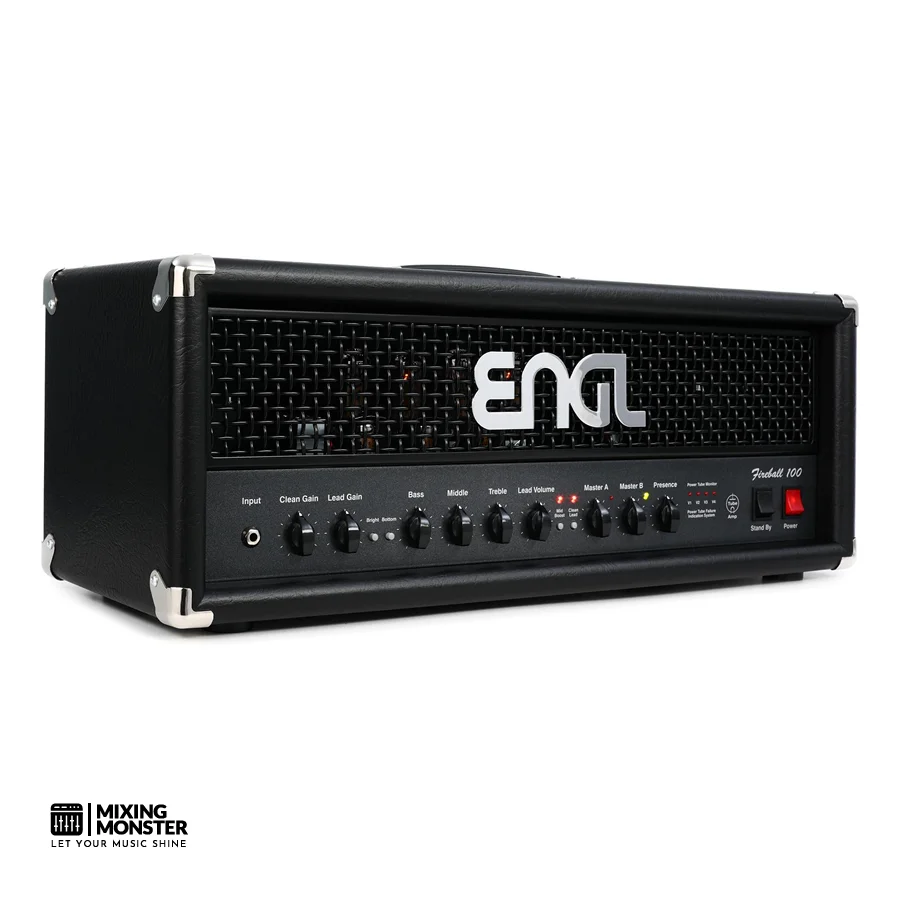
Best High-End
EVH
5150 III 100S
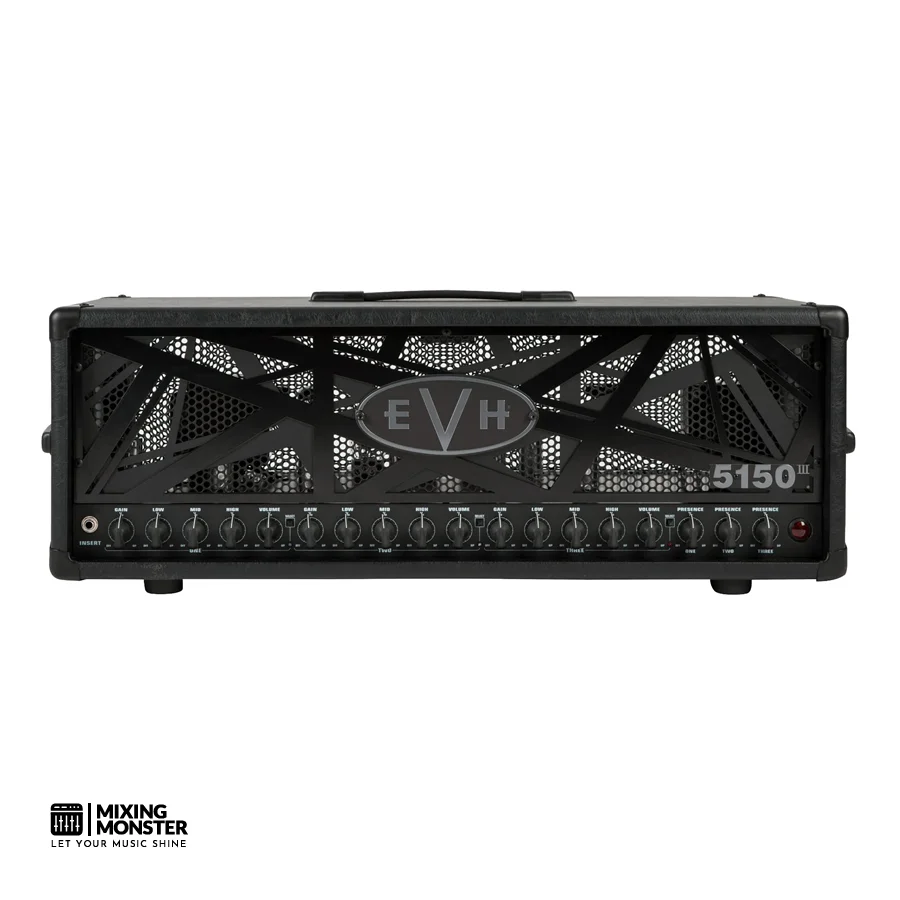
Best Iconic
Soldano
SLO 100 Classic
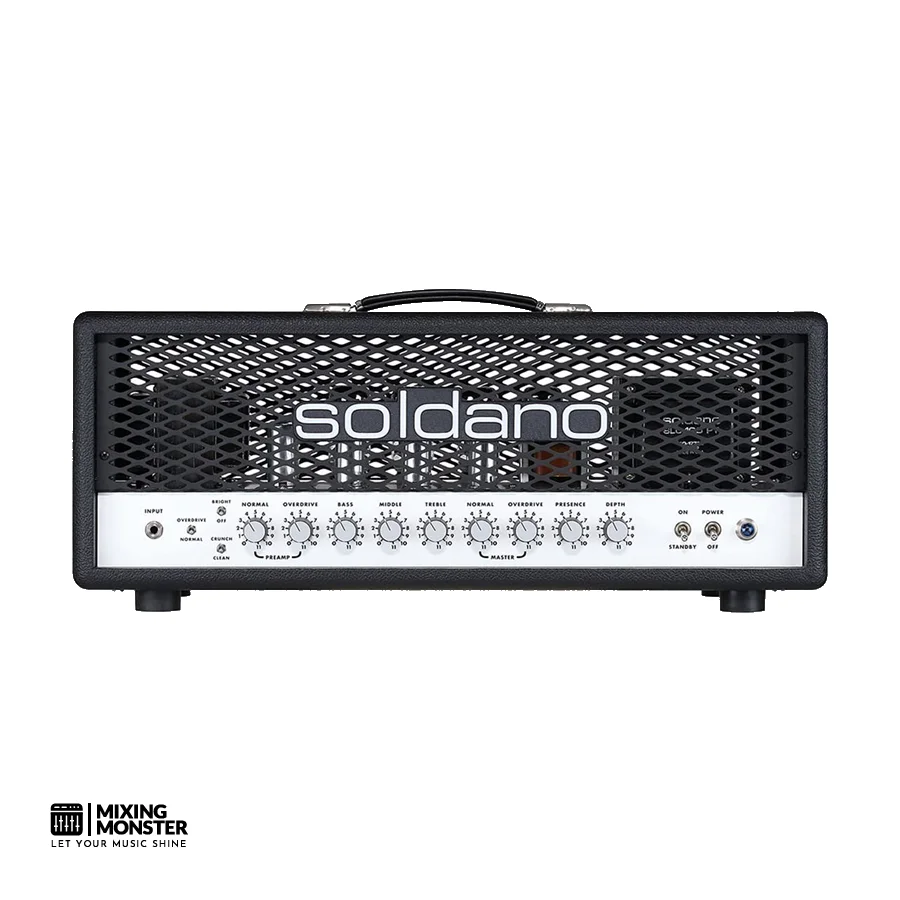
Table Of Contents
1. What Are The Best Guitar Amp Heads?
Best Budget Guitar Amp Heads
Best Midrange Guitar Amp Heads
Best High-End Guitar Amp Heads
Best Iconic Guitar Amp Heads
2. What Is A Guitar Amp Head?
3. Essential Accessories To Complement Your Guitar Amp Head
4. Guitar Amp Head Buying Guide
5. Finding Your Perfect Guitar Amp Head: Key Takeaways
FAQ

1. What Are The Best Guitar Amp Heads?
Here’s our handpicked list of the best guitar amp heads. We judged each model by sound, reliability, and value—hopefully making your search a little less overwhelming.
Here Are Our Picks For The Best Guitar Amp Heads:
Best Budget Guitar Amp Heads
Best Midrange Guitar Amp Heads
5. Hughes & Kettner Triamp Mark 3
Best For Ultimate Versatility And Studio-Grade Tone Control
Best High-End Guitar Amp Heads
Best Iconic Guitar Amp Heads
12. Mesa Boogie IIC+ HRG
Best For High-Gain Legends And Studio Professionals
13. Mesa Boogie 90s Dual Rectifier
Best For Iconic Modern Metal And Hard Rock
17. Diezel VH4
Best For Legendary Boutique Tube Tone

Best Budget Guitar Amp Heads
#1 Hughes & Kettner TubeMeister Deluxe 20
Best For Studio Recording, Home Practice, And Small Venue Performance
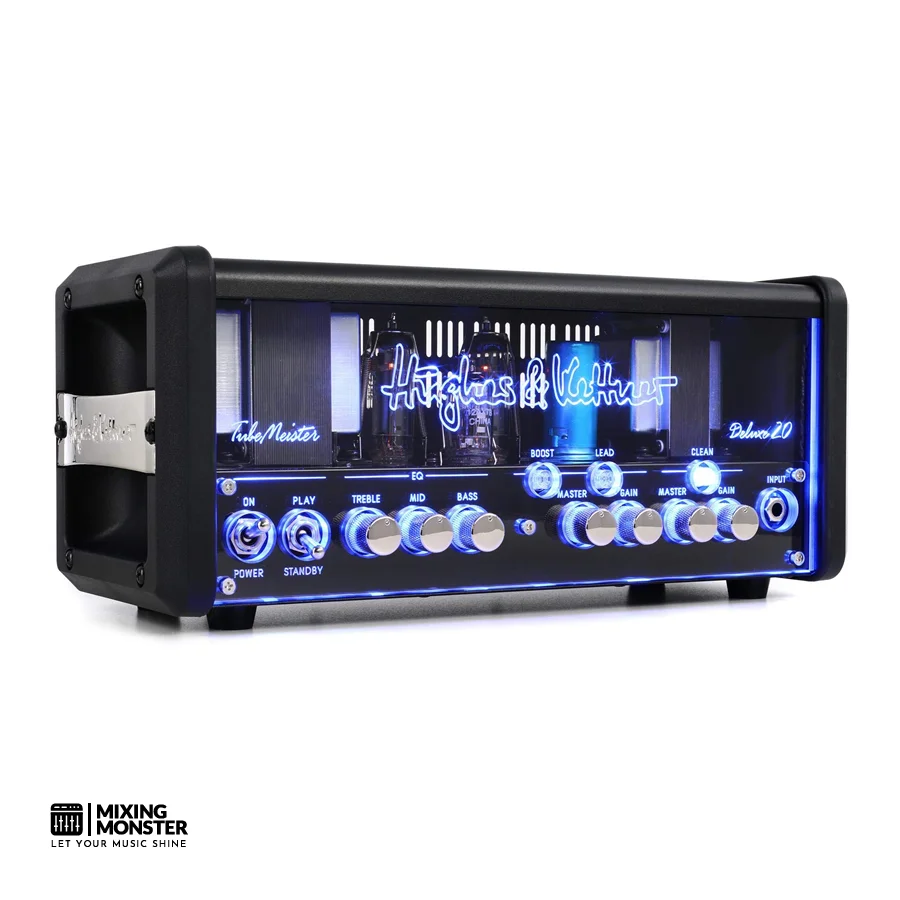
Overview:
The Hughes & Kettner TubeMeister Deluxe 20 delivers authentic tube tone and a wealth of flexibility for both studio and live use. This two-channel head lets you dial the power down from 20 watts to 1, making it suitable for everything from late-night practice to small gigs.
We found the built-in Red Box DI to be super handy for direct recording—no microphone needed. The amp retains its tube vibe at any power setting, although it definitely leans into that classic Hughes & Kettner flavor.
Pros:
- Power scaling from 20W to 1W keeps tube saturation even at low volumes
- Red Box DI means you can record directly without fussing with mics
- The serial effects loop keeps your time-based effects sounding clean
Cons:
- Single shared EQ makes it tough to balance both channels perfectly
- Doesn’t offer as many tones as some other amps at this price
- Some folks report reliability issues after heavy use
Unique Selling Point:
The TubeMeister Deluxe 20‘s power soak feature (including silent recording mode) lets you get real tube saturation with zero speaker output. That’s a lifesaver for recording at home.
Key Benefits:
- Flexible Power Options – You can get natural tube compression at quiet, apartment-friendly levels or crank up to 20 watts for small gigs.
- Direct Recording Capability – The Red Box DI delivers a speaker-simulated signal directly to your audio interface or mixer.
- Two-Channel Versatility – Clean and lead channels give you the basics for flipping between rhythm and solos without a fuss.
Pricing:
| Average Price | ~ $854 |
Review:
After putting the Hughes & Kettner TubeMeister Deluxe 20 through its paces at home and in the studio, it delivers a genuine tube sound with some modern enhancements.
The power scaling is spot-on—whether we’re sneaking in a 1-watt late-night session or blasting 20 watts at rehearsal, the tone stays true. The clean channel maintains sufficient headroom at higher settings, and the lead channel delivers a nice, harmonically rich bite that responds well to your picking dynamics.
The Red Box DI was a game-changer during recording. We could chase our favorite tube breakup and send a steady signal right to our interface, skipping the whole mic-and-room hassle. The speaker sim is quite convincing for demos and quick tracks, although we still prefer miking a cab for final takes.
Balancing the two channels can get tricky with the shared EQ. Sometimes we had to compromise—what sounded great on clean wasn’t always perfect on lead. If you mostly stick to one channel and only switch occasionally, you’ll probably be fine, but tone-tweakers might get a little frustrated.
The build quality feels solid, but we’ve seen some reports of reliability issues after a few years. The compact size of the TubeMeister makes it easy to carry around, and the feature set covers most modern needs. The effects loop plays nicely with our delay and reverb pedals, keeping everything crisp from start to finish.
#2 Orange Dual Terror
Best For Guitar Players Seeking Dual-Channel Tube Tone In A Compact Package

Overview:
The Orange Dual Terror takes the classic Tiny Terror vibe and adds a second channel plus 30 watts of EL84 tube punch. This amp head delivers that unmistakable Orange tone in a surprisingly small box.
We appreciated the simple controls—it’s quick to dial in a sound that works. Four EL84 tubes provide ample clean headroom, and when you crank it, you get that gritty Orange crunch everyone loves.
Pros:
- Delivers the real Orange tube flavor with plenty of clarity and warmth
- Dual channels give you options without overcomplicating things
- Small and light enough for easy gigging.
Cons:
- Not as many tone-shaping tricks as some pricier heads
- Channel switches feel a bit flimsy compared to the rest of the build
- Players who want sparkling clean tones at high volumes might feel limited.
Unique Selling Point:
The Orange Dual Terror nails two distinct classic Orange tones without the bulk or headache of bigger, feature-packed heads.
Key Benefits:
- Authentic tube saturation – Four EL84s serve up natural compression and those sweet harmonics that really respond to your playing
- Stage-ready portability – At just 24 pounds, it’s easy to carry but still packs enough power for most live gigs
- Simplified operation – Three knobs per channel keep things straightforward, but you still get all the essential tones
Pricing:
| Average Price | ~ $949 |
Review:
We’ve logged plenty of hours with the Orange Dual Terror and keep coming back to how much classic Orange attitude it packs into such a manageable size.
The first channel is excellent for clean sounds and edge-of-breakup tones, while the second channel delves into gritty rock territory with absolute authority. Both channels maintain their clarity, even when pushed to their limits.
The power scaling is genuinely helpful—this head has held its own in both small bars and bigger rooms. The EL84 tubes provide a nice, warm compression that makes single notes sing and chords stay full without becoming muddy.
Orange’s reputation for solid build quality holds up here, though we wish the channel switches felt as tough as the rest of the amp. The control panel is laid out logically, and after a couple of sessions, it’s second nature.
Tone-wise, this head really shines for rock and blues. If you’re chasing pristine cleans or ultra-heavy metal sounds, it’s probably not the best fit. But for that classic Orange midrange snarl that slices through a mix? It’s hard to beat.
The Orange Dual Terror is a no-nonsense choice for players who care more about killer tone than endless features. Its simplicity makes it more fun—you spend less time fiddling and more time playing.
#3 ENGL E633 Fireball 25
Best For High-Gain Metal Players, Home Studio Recording, And Moderate Volume Venues

Overview:
The ENGL Fireball 25 brings real-deal tube-driven metal tones with its 25-watt setup. It runs on a pair of 6L6GC power tubes and leans hard into heavy, saturated sounds.
We noticed that it retains the classic ENGL flavor, but you can crank it up to bedroom levels. The built-in power soak lets you push the tubes into saturation without shaking the walls.
Pros:
- High-gain lead channel with tight, punchy low end
- Power soak delivers tube tone at neighbor-friendly volumes
- Simple controls—dialing in tones is fast and painless
Cons:
- A clean channel isn’t as sparkly or open as a true clean amp
- Not the most versatile for genres outside high-gain territory
- Pricey compared to other 25-watt tube heads
Unique Selling Point:
The ENGL Fireball 25 sports a built-in noise gate that squashes feedback but keeps your notes clear, even when you’re chugging away on palm mutes.
Key Benefits:
- Professional Metal Tones: The lead channel produces thick distortion that slices through a mix without ever becoming mushy.
- Volume Flexibility: That power soak is a lifesaver—full tube grind at apartment levels, and the tone stays solid.
- Simple Operation: The no-nonsense layout means you’re not fiddling with knobs for hours, whether you’re on stage or tracking at home.
Pricing:
| Average Price | ~ $1350 |
Review:
The ENGL Fireball 25 made a strong first impression. Flipping it on, those tubes heat up quickly and settle into a sweet spot that feels right. The lead channel’s distortion is thick, but still lets every note ring out, even when tuned down to drop Z or whatever’s fashionable now.
We tried to coax more from the clean channel, but it’s okay. It’ll work for rhythm parts or as a pedal platform, but don’t expect glassy, boutique cleans here.
The power soak proved particularly useful during our test runs. We could push the amp into that natural tube squish without blasting our ears off. It’s a huge plus for home use or small gigs where you can’t go full volume.
The built-in noise gate surprised us—in a good way. It doesn’t chop off your notes like some external gates do. Instead, it keeps things quiet between riffs but lets your sound breathe. The mid-boost switch is a nice touch for cutting through a busy mix as well.
The build quality of the Fireball 25 feels rock-solid, aligning perfectly with the ENGL vibe. The chassis has heft, and all the controls turn smoothly—no scratchiness or dead spots. It’s clear ENGL put some real thought into which controls you’ll actually need to reach for on the fly.
Best Midrange Guitar Amp Heads
#4 Vox AC30H
Best For Vintage-Inspired Guitarists Seeking Authentic Tube Warmth With Modern Versatility
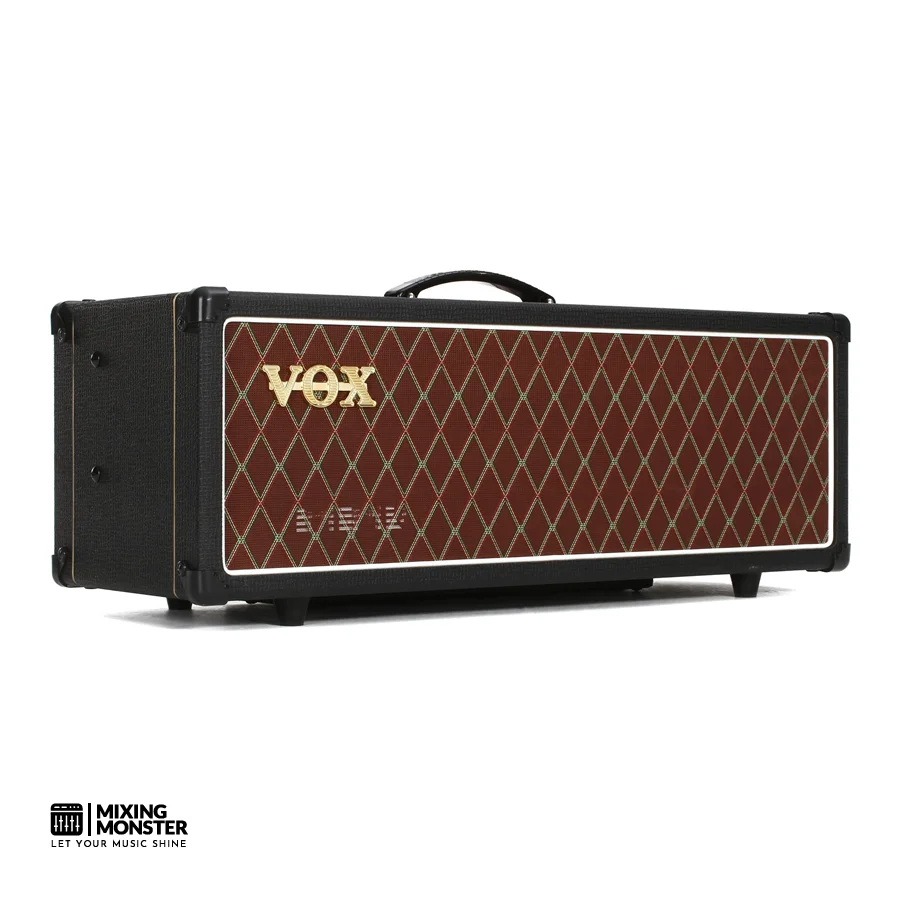
Overview:
The VOX AC30CH brings classic British tube tone in a 30-watt all-tube head. You get two channels with their own volume controls, plus that iconic VOX Top Boost circuit.
With EL84 power tubes and 12AX7 preamp tubes, it exudes a rich vintage character. Built-in spring reverb and a true-bypass effects loop add modern flexibility to the mix.
Pros:
- Classic VOX warmth, chime, and sparkle
- Dual channels for swapping between clean and drive
- Portable head—small size, big sound
- Interactive tone controls for deep sound shaping
- Spring reverb gives you that lush, natural space
Cons:
- At 44 pounds, it’s not exactly lightweight
- Tubes need replacing and occasional TLC
- Needs to be cranked a bit for real tube breakup
- Not ideal for modern high-gain tones
Unique Selling Point:
The AC30CH nails that legendary AC30 vibe in a portable head, so you get all the British chime without lugging a giant combo amp.
Key Benefits:
- Authentic Tube Response – The EL84/12AX7 combo delivers natural compression and harmonics that respond authentically to your playing.
- Tonal Flexibility – Two channels and interactive EQ let you jump from glassy cleans to creamy overdrive in a snap.
- Professional Integration – The effects loop and tone cut make pedalboards and stage setups a breeze.
Pricing:
| Average Price | ~ $1649 |
Review:
From the outset, the VOX AC30CH felt special. Those EL84s glow, and you know you’re in for that classic VOX chime—no disappointment there: clean tones shimmer, and the midrange cuts through without ever becoming harsh or brittle.
On the Top Boost channel, the amp really comes alive. We dialed in everything from percussive jangle to smooth lead tones with sustain for days. The treble and bass controls interact in an oddly satisfying way—it makes you want to experiment. Even at moderate volumes, you get that touch-sensitive tube squish under your fingers.
The spring reverb is spot-on for vintage flavor—drippy when you want it, subtle when you don’t. It responds to your playing, which is a lot of fun. The tone cut is handy for taming brightness, especially when using single coils.
The effects loop does its job—no tone suck, no weird volume drops. We ran a bunch of pedals through it, and everything stayed clear. The 30-watt power section provides sufficient clean headroom, but you will need to crank it up a bit for full-on tube saturation.
After putting it through its paces, we’re convinced the AC30CH is a true successor to the classic combo. Sure, it’s hefty, but if you want that British tube magic in a portable head, it’s tough to beat.
There’s just something about the way it handles both vintage and modern needs at once—it’s not trying too hard, but it delivers.
#5 Hughes & Kettner Triamp Mark 3
Best For Ultimate Versatility And Studio-Grade Tone Control

Overview:
The Hughes & Kettner TriAmp Mark 3 is a 150-watt, six-channel tube amplifier that produces a wide range of tones—anything from glassy cleans to brutal metal crunch.
Designed squarely for working guitarists, the TriAmp’s programmable setup and two separate power stages make it ridiculously flexible. We loved how it handled both gigs and recording sessions, thanks to its clear sound and straightforward controls.
Pros:
- Six totally independent channels for just about every tone you’d want
- Easy programming and full MIDI control
- Top-tier build and unmistakable German engineering
- Super clear, super dynamic response
- Red Box DI for direct recording—no fuss
Cons:
- Definitely pricier than basic tube heads
- It’s a bit of a learning curve if you’re new to pro amps
- It’s heavy—don’t expect to toss it in a backpack
Unique Selling Point:
Six channels on the TriAmp Mark 3 and a fully programmable tube setup mean you can jump from clean funk to face-melting distortion instantly, all while keeping that genuine tube warmth. That’s rare.
Key Benefits:
- Total Tonal Freedom: Nails everything from old-school cleans to modern, saturated gain.
- Professional Integration: MIDI and Red Box DI make it easy to fit into any rig, live or in the studio.
- Exceptional Build: German design, built to last and sound consistent night after night.
Pricing:
| Average Price | ~ $1650 |
Review:
We’ve put the TriAmp Mark 3 through its paces, and honestly, it’s easy to see why so many players call it a flagship. Each channel feels like its own amp, and you can cover just about any genre.
Cleans have that classic sparkle, and when you switch to crunch or lead, you get thick, punchy tones that totally remind us of vintage British stacks.
On stage, the MIDI switching is a lifesaver. We could seamlessly transition between wildly different sounds without missing a beat, and the clarity remained rock-solid even when we cranked it.
The Red Box DI is also a standout—direct recording sounds convincing, and you can go straight to PA or headphones with zero hassle.
Sure, the TriAmp Mark 3 is not cheap. But if you want maximum flexibility and pro-level tones, it’s hard to beat. It’s a big, complex amp—probably overkill for bedroom players—but for serious musicians who care about tone, it’s a dream rig.
#6 ENGL Fireball 100 E635
Best For High-Gain Metal Players And Professional Musicians

Overview:
The ENGL Fireball 100 packs a punch with four 6L6GC power tubes and a streamlined control layout. This 100-watt head excels at producing tight, aggressive metal tones while maintaining articulation, even with the gain turned up to the max.
It’s got two channels and sticks to the essentials. Clean tones are clear enough, but the lead channel is where the real magic happens—thick saturation that’s perfect for modern metal.
Pros:
- Superb high-gain clarity with built-in noise gate
- 100-watt output—plenty for big stages
- Extensive EQ and boost options for dialing in your sound
Cons:
- Clean headroom is limited (not a jazz amp)
- Weighs in at 51.8 pounds—definitely not a featherweight
- Pricier than most entry-level heads
Unique Selling Point:
The Fireball 100 zeroes in on high-gain tones while somehow maintaining musicality and clarity at any setting.
Key Benefits:
- Professional Power Output – The 100-watt platform provides ample headroom for both gigs and the studio, without compromising your tone.
- Advanced Tone Control – Bright, bottom, and mid boost switches let you carve out your signature sound with surprising precision.
- Effects Integration – Buffered effects loop keeps your signal clean when you’re stacking pedals.
Pricing:
| Average Price | ~ $1900 |
Review:
The ENGL Fireball 100 made its intentions clear from the first note. The lead channel keeps your notes crisp and defined, even when you’re deep in distortion territory. That built-in noise gate works quietly in the background, squashing feedback but letting your sustain ring out.
Power delivery feels rock-solid at any volume. We ran it through a few different cabs and, honestly, it seemed happiest with vintage 30s. The clean channel is serviceable for rhythm, but it’s not here to win any awards for glassy cleans—it’s really just a launchpad for the lead channel.
Build quality is what you’d expect from ENGL—solid, pro-level stuff. The controls are laid out logically, so you’re not hunting for anything mid-song. The buffered effects loop kept our signal pristine, even with several time-based pedals in the chain.
Presence control adds some brightness, but never gets shrill.
Volume is no joke with this amp. Even at halfway up, it’s loud. If you plan to use it at home, you’ll want to use an attenuator. The amp responds well to your guitar’s volume knob, which is a plus for players who frequently employ dynamic playing techniques.
The Fireball 100 held up well during long sessions—no weird overheating or tube drift. Everything about it feels as though it was built to last. If you’re a metal player after pro-grade high-gain tones without a lot of extra fluff, the Fireball 100 absolutely delivers.
#7 Peavey 6505 II
Best For High-Gain Rock Guitarists Seeking Professional Tube Tone
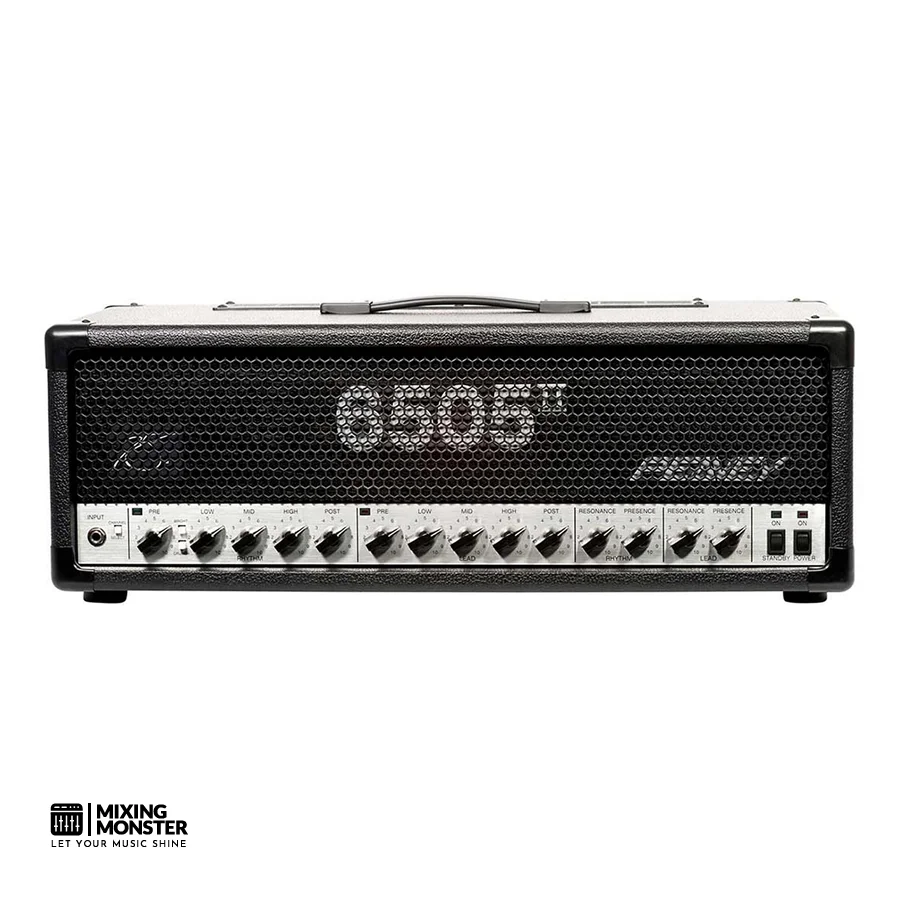
Overview:
The Peavey 6505 II Head takes the classic 6505 formula and adds more channel flexibility, along with a significantly improved clean channel. You get 120 watts of tube power—six 12AX7s in the preamp and four 6L6GCs in the power section.
Both channels have their own EQ, resonance, and presence controls, which is a huge plus. The clean channel really feels like a step up from the old model. A three-button footswitch controls channel selection, effects loop, and the crunch function, all hands-free.
Pros:
- Separate EQ sections for each channel offer outstanding tonal flexibility
- Redesigned clean channel finally gives you genuine clean tones
- The footswitch lets you handle channel and effects changes without leaving the guitar
Cons:
- Weighs in at 48 pounds—moving it is no joke
- High-gain voicing isn’t for everyone; blues or vintage fans may want to look elsewhere
- Single rating so far, so real-world feedback is a bit scarce
Unique Selling Point:
The Peavey 6505 II Head stands apart with dedicated EQ, resonance, and presence controls for each channel, giving you way more precise tonal shaping than the original 6505 ever did.
Key Benefits:
- Enhanced Channel Independence – Each channel has its own full set of tone controls, so you can dial in wildly different sounds without making sacrifices
- Improved Clean Performance – The clean channel uses its own 12AX7 tube and finally delivers real clean tones
- Complete Footswitch Control – The three-button footswitch manages channels, effects loop, and crunch, all remotely
Pricing:
| Average Price | ~ $1999 |
Review:
The Peavey 6505 II Head really feels like a proper update to a legendary amp. The channel separation is instantly noticeable—you can now achieve a true, clean sound, not just a slightly distorted one. That alone makes it more usable for different genres or pedal setups.
Having independent resonance and presence for each channel is a game-changer—no more compromise between clean and lead settings. The lead channel still brings that brutal, saturated distortion everyone expects from the 6505, but the clean side is finally something you can build a pedalboard around.
Peavey’s reputation for tough, gig-ready gear holds up here. The six 12AX7s and four 6L6GCs give you plenty of headroom and punch. Bias test points on the back make tube maintenance less intimidating, and the impedance selector means you can hook up just about any cab you want.
The footswitch of the Peavy 6505 works exactly as you’d hope. Flipping the crunch boost or effects loop on and off with your foot is a real workflow improvement, especially on stage. No more awkward tap-dancing or reaching down mid-song.
The only real downside? It’s heavy. At 48 pounds, you’ll want a friend to help load it in and out, especially if you gig a lot. Additionally, if you’re seeking vintage Marshall or Fender tones, this isn’t the amp for you; it’s designed for modern rock and metal, where aggressive distortion is a key element.
Best High-End Guitar Amp Heads
#8 Marshall 1959 HW
Best For Classic Rock Purists And Vintage Tone Enthusiasts
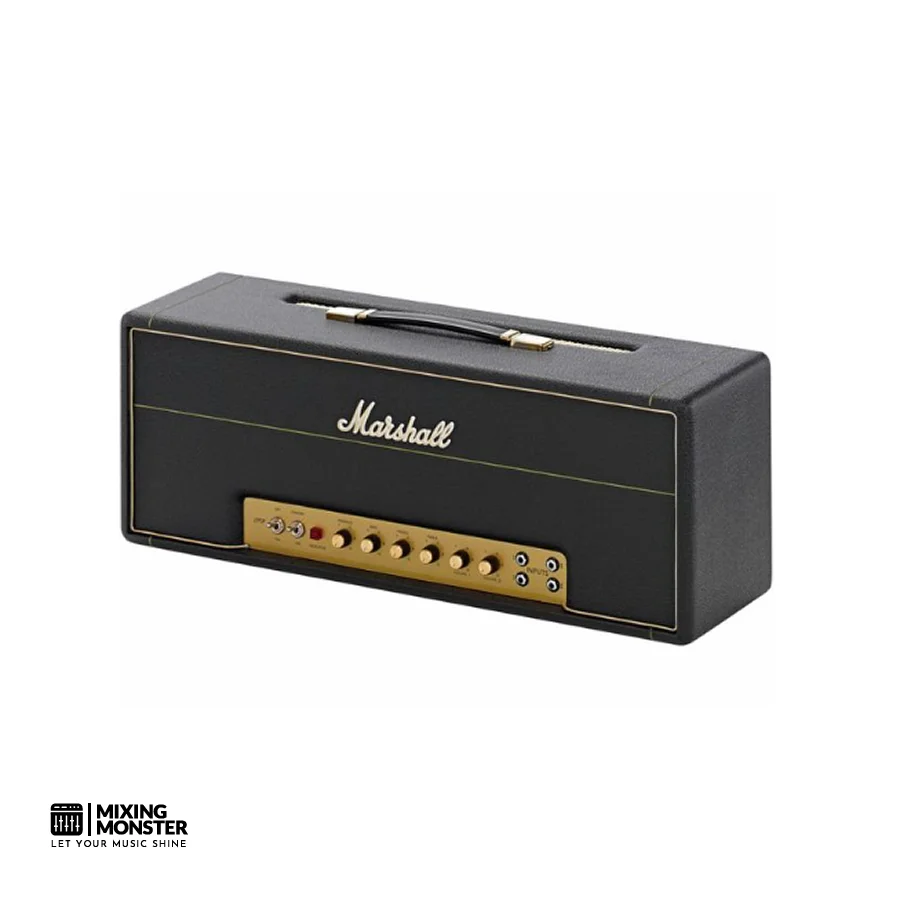
Overview:
The Marshall 1959 Handwired (HW) head recreates the legendary Plexi sound that defined rock in the late 1960s and 1970s. This amp oozes classic Marshall growl, with touch sensitivity and raw tube power that really rewards expressive playing. It’s stripped down, built for those who crave authenticity and don’t mind a little volume.
Pros:
- Handwired circuit delivers vintage tone
- That iconic Marshall crunch and sustain
- Controls are dead simple and intuitive
- Feels like it’ll last forever
Cons:
- No master volume, so you’ve gotta play loud to get the magic
- Not the most versatile amp out there
- Big, heavy, and not exactly apartment-friendly
Unique Selling Point:
The Marshall 1959 handwired, all-tube design nails the exact tone and feel of the original Plexi—just like the amps the classic rock gods played.
Key Benefits:
- Authentic Sound: You get that unmistakable classic rock vibe, straight out of the box.
- Handcrafted Quality: Built with a real eye for vintage detail.
- Dynamic Feel: It responds to your touch and guitar volume in a way that’s just inspiring.
Pricing:
| Average Price | ~ $2044 |
Review:
Plugging into the Marshall 1959 HW, it’s immediately apparent why this thing is legendary. The tone is raw and alive—think Hendrix, Page, Clapton. Every note pops, with that natural compression and sweet harmonics you only get from a real Plexi.
You won’t find modern bells and whistles here—no master volume, no reverb, no channel switching—just pure, old-school tube tone. We achieve the best sound by running it through a good attenuator or a reactive load box, especially in modern setups.
If you want that authentic, unfiltered rock experience, the Marshall 1959 HW delivers. It’s not for everyone (your neighbors might hate you), but on stage or in the studio, it’s a beast.
#9 EVH 5150 III 100S
Best For Metal Guitarists, Touring Musicians, And Eddie Van Halen Tone Seekers

Overview:
The EVH 5150III 100S Head hits hard with three distinct channels and custom mods straight from Eddie’s touring rig. This 100-watt all-tube beast utilizes eight JJ ECC83 preamp tubes and four 6L6s in the power section, providing ample tube saturation. It’s built for pro use and handles everything from glassy cleans to absolutely crushing high-gain leads.
Pros:
- High-gain channel delivers massive distortion
- Three channels cover clean, crunch, and lead territory
- Authentic Eddie Van Halen sound with custom touring mods
- Professional-grade tube build and adjustable bias
- Switchable output impedance for cab flexibility
Cons:
- Clean channel isn’t as warm or open as some dedicated clean amps
- The volume pot can be a bit finicky when adjusting gain
- At 62.8 pounds, it’s a workout to move it
- Limited edition, so replacement parts could be tricky down the line
- Pricey—definitely not for the casual player
Unique Selling Point:
The EVH 5150III 100S Head is basically Eddie Van Halen’s touring amp in a box, with his personal tweaks and all the exclusivity that comes with it.
Key Benefits:
- Professional High-Gain Performance – The lead channel delivers massive distortion for metal and hard rock, eliminating the need for pedals.
- Tour-Ready Reliability – Built to last with professional-grade tubes and components, it’s ready for the road or the studio.
- Tonal Versatility – Three channels mean you can cover clean, crunch, and lead tones, from jazz to the heaviest metal.
Pricing:
| Average Price | ~ $2569 |
Review:
We’ve put the EVH 5150III 100S Head through its paces, and it nails that Van Halen vibe right out of the gate. As soon as you power it up, the signature high-gain roar takes over the room. Channel three, in particular, has so much gain on tap that it slices through a mix without getting mushy or squashed.
The three-channel setup is genuinely versatile. Channel one gives you decent cleans, though it doesn’t have the sparkling headroom you’d get from a Fender Twin or something similar. Push the gain up, and it morphs into a crunchy rhythm machine—great for classic rock.
Channel two sits in that sweet spot for rhythm work—plenty of bite, but not over the top. The lead channel, though, is where things really get wild; it pours out smooth, saturated distortion with endless sustain.
This head feels solid, built to survive years of gigging. That said, we have noticed that the volume pots sometimes malfunction after extended periods of use. The taper can be slightly uneven, which makes dialing in the perfect level a bit tricky at times.
It’s a heavy amp—62.8 pounds is no joke. We’d love to see some better handles for hauling it around. On the plus side, the switchable output impedance is super handy if you’re swapping cabs between gigs or sessions.
If you’re chasing Eddie’s touring tone and want a pro-level amp that screams rock and metal, the EVH 5150III is your choice. It’s not cheap, but for diehards, it’s worth every penny.
#10 Orange Rockerverb 100 MKIII
Best For High-Gain Rock And Metal Players Seeking British Tube Tone
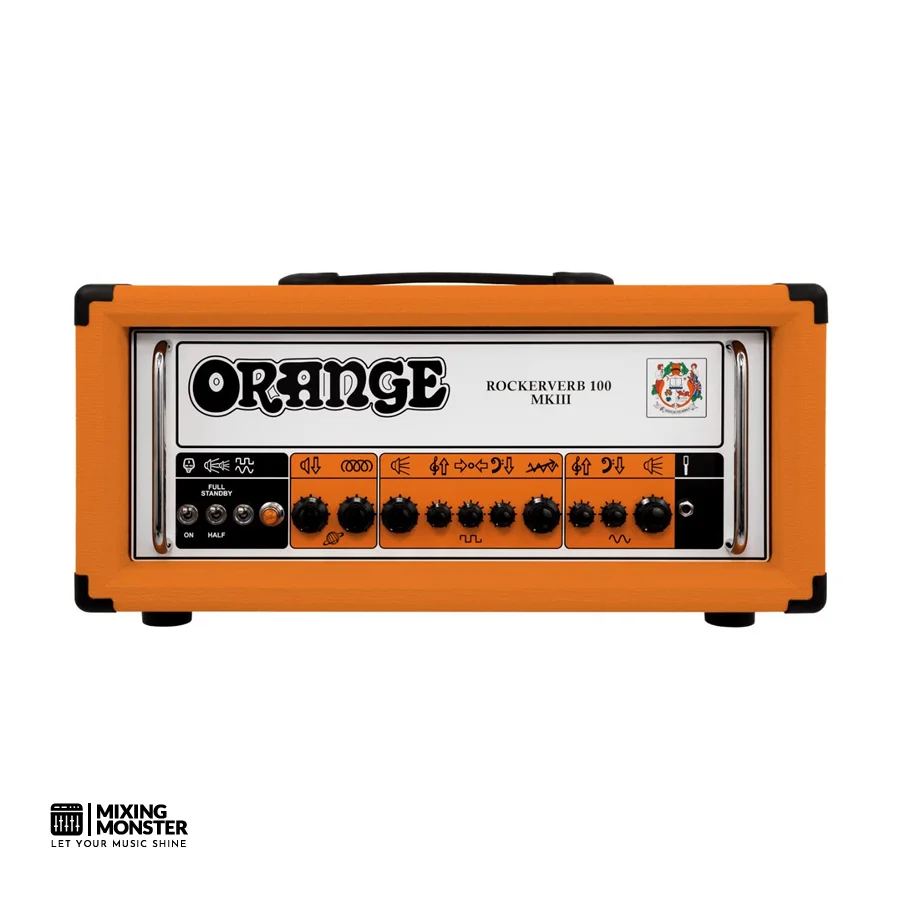
Overview:
The Orange Rockerverb 100 MKIII continues to refine the high-gain British tube amp recipe. This 100-watt all-tube head has two channels—a revoiced clean and a dirty channel that covers everything from classic crunch to modern metal.
Orange features built-in power scaling and a footswitchable attenuator, allowing you to achieve saturated tones at any volume. Everything runs through a 100% tube-driven circuitry, including spring reverb and the effects loop.
Pros:
- All-tube path delivers warm, unmistakable British tone
- Power-scaling and attenuation make it usable anywhere, from bedroom to stage
- Dual channels range from chimey cleans to heavy distortion
Cons:
- At 58 pounds, it’s not exactly portable
- High price tag—definitely not a budget buy
- Not a ton of customer reviews yet, so long-term reliability is a bit of an unknown
Unique Selling Point:
The Rockerverb 100 MKIII offers power scaling and footswitchable attenuation, enabling you to achieve the perfect balance of tube saturation at any volume while maintaining your signature Orange sound.
Key Benefits:
- Tonal Versatility – The clean channel features more sparkle and clarity than before, while the dirty channel encompasses everything from vintage crunch to modern gain.
- Volume Management – Power scaling and attenuation let you achieve real tube compression without blowing out your ears or the room.
- Professional Features – A tube-driven effects loop and spring reverb preserve your tone while adding useful extras.
Pricing:
| Average Price | ~ $2749 |
Review:
We spent a considerable amount of time with the Rockerverb 100 MKIII, and, honestly, it delivers the big, British tube sound that Orange is famous for. The clean channel is significantly improved—now you can get everything from sparkling cleans to just-on-the-edge breakup, and it responds really well to your playing style.
The dirty channel is where the amp really shines. We ran it from low to high gain and found it’s just as happy doing classic rock as it is chugging out modern metal riffs. Even with the gain dimmed, you don’t lose clarity, which is a rare quality.
Power-scaling quickly became one of our favorite features. You can get that saturated tube tone at low volumes for practice, or unleash the full 100 watts on stage. The footswitchable attenuator is a lifesaver in live settings.
Orange’s build quality is as solid as ever. At 58 pounds, though, you’ll feel every step of the load-in. The spring reverb adds a nice touch of space without washing out your core sound.
The effects loop does its job perfectly—our pedals sounded just as they should, with no loss of signal or character. The tube-driven loop keeps everything sounding organic and lively.
All in all, the Orange Rockerverb 100 MKIII nails that pro-level British tube tone, and the modern features make it a lot more practical than most amps in its class.
#11 ENGL Savage 120 E-610 MKII
Best For High-Gain Metal Guitarists And Large Venues
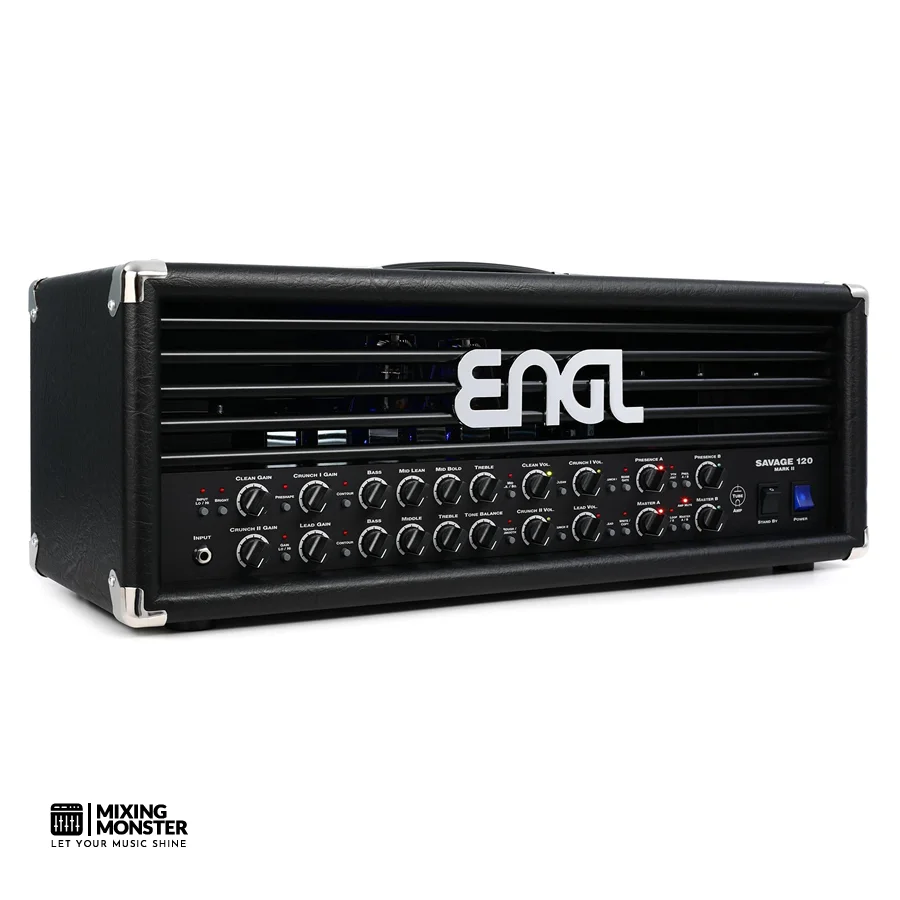
Overview:
The ENGL Savage 120 Mark II is a brute of a tube amp head, built for modern metal players who want their tone to punch through walls. German engineers really went to town here—this thing blasts out 120 watts of tube-driven fury across four channels.
Dual four-band EQs and two tube-buffered effects loops give you all the flexibility you could want. At 57.3 pounds, it’s not something you’ll want to lug up a flight of stairs every night, but the build quality is classic ENGL—solid, heavy, and made to last.
Pros:
- High-gain tones cut like a scalpel—ideal for metal
- MIDI integration makes preset switching during gigs a breeze
- Four completely independent channels cover everything from clean to brutal
Cons:
- It’s heavy—transporting this beast isn’t for the faint of heart
- The control layout feels overwhelming at first
- Pricey enough to make most intermediate players wince
Unique Selling Point:
The ENGL Savage 120‘s tube-buffered effects loops and power tube monitoring system scream reliability—something you really need if you’re playing night after night on the road.
Key Benefits:
- Four-Channel Versatility – You get everything from lush, sparkling cleans to face-melting distortion, all without having to compromise or swap amps mid-set. Handy for those who play a variety of instruments in one show.
- MIDI Control Integration – Built-in MIDI lets you program preset changes that sync up with your backing tracks or lights. It’s surprisingly painless once you get the hang of it.
- Professional Reliability – The power tube monitoring and that tank-like German build mean you can count on it night after night, even if you’re rough on your gear.
Pricing:
| Average Price | ~ $3000 |
Review:
After putting the ENGL Savage 120 Mark II through its paces, I can say it absolutely nails those aggressive, modern metal tones. The first channel actually surprised me with how warm and clean it sounded, and then channels two, three, and four ramp up the gain and bite.
Each channel reacts really nicely to your picking—dig in, and it snarls; back off, and it cleans up, even when you’re cranking the distortion.
The dual four-band EQs offer extensive control. You can scoop the mids for a classic metal sound or push them for an old-school rock vibe. The tube-buffered effects loops are a lifesaver if you’re running a big pedalboard—your signal stays clear no matter how many pedals you throw at it.
MIDI works as advertised. I set up several presets and was able to switch between them seamlessly during a song without any issues. The built-in noise gate keeps everything tight and quiet between songs—honestly, that alone saved me from needing another pedal on my board.
The build quality is top-tier, but it’s also quite heavy. The metal chassis feels sturdy enough to withstand a fall from the stage, and all the knobs and switches remain smooth after months of use. Even after long, loud sessions, it doesn’t overheat or act up.
The controls take some getting used to—a lot is happening—but once you figure them out, the sound and flexibility are worth it. For serious metal players who want pro-level tone and reliability, the ENGL Savage 120 Mark II is a killer investment.
Best Iconic Guitar Amp Heads
#12 Mesa Boogie IIC+ HRG
Best For High-Gain Legends And Studio Professionals
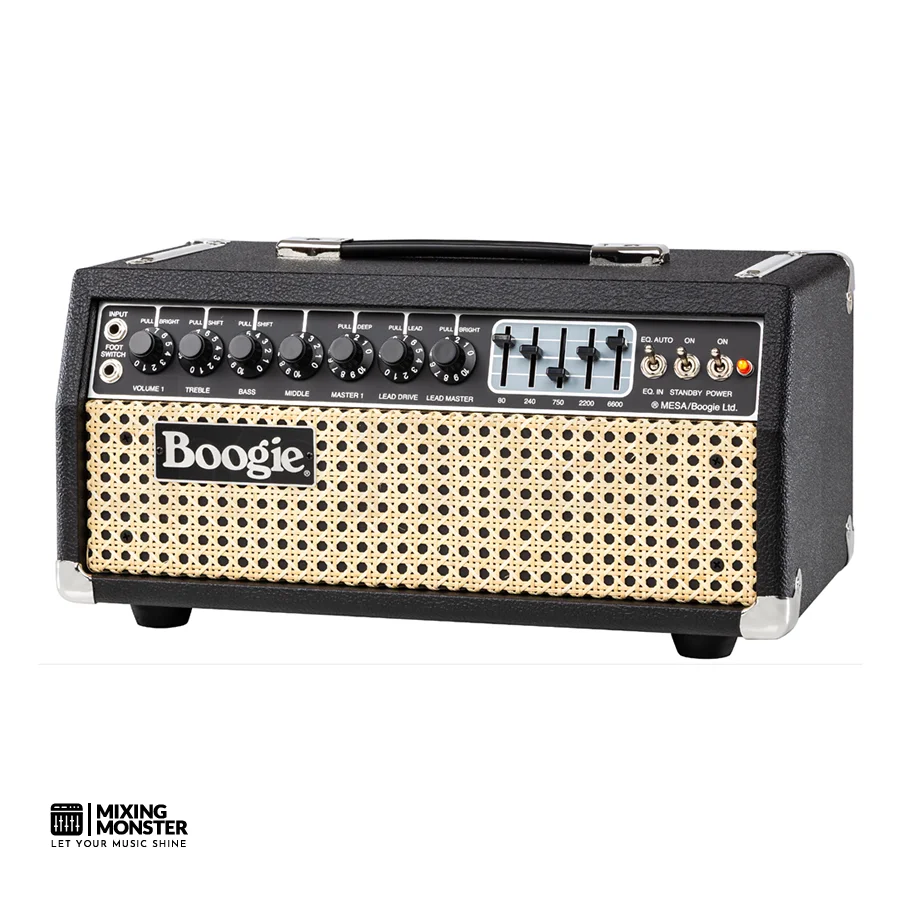
Overview:
The Mesa Boogie IIC+ HRG Head is a fresh take on the legendary Mark IIC+. Known for its singing sustain and sharp precision, this amp excels in both leads and rhythms, featuring tight lows, articulate highs, and a boutique feel—this one’s for serious tone chasers.
Pros:
- Classic Mark IIC+ sound with some modern tweaks
- Sustain and note clarity are just unreal
- Graphic EQ for deep tone shaping
- Responds to every nuance of your playing
Cons:
- Pricey and not easy to find
- Controls can feel overwhelming at first
- Heavy and pulls a lot of juice
Unique Selling Point:
The IIC+ HRG Head stands out for its faithful recreation of the original Mark IIC+ circuit. That signature singing lead tone and clarity under gain? It’s all here.
Key Benefits:
- Studio-Grade Precision: Ideal for recording pristine, high-gain tones.
- Dynamic Expression: Every touch and volume change comes through.
- Customizable EQ: The graphic EQ allows you to tailor your sound precisely.
Pricing:
| Average Price | ~ $3890 |
Review:
The Mesa Boogie IIC+ HRG Head is honestly in a league of its own. We’ve played a ton of amps, but few combine this level of clarity and aggression like this one.
The clean channel sparkles, and the lead channel provides that smooth, liquid sustain that made the original IIC+ a favorite among players like Hetfield and Petrucci.
In the studio, the IIC+ is a total standout. The graphic EQ lets you dial in mix-ready tones without any extra gear, and it reacts to your playing with insane detail.
It’s not the easiest amp to plug in and go, but if you’re willing to learn its quirks, the payoff is enormous. The IIC+ HRG Head is a true blend of vintage mojo and modern precision.
#13 Mesa Boogie 90s Dual Rectifier
Best For Iconic Modern Metal And Hard Rock
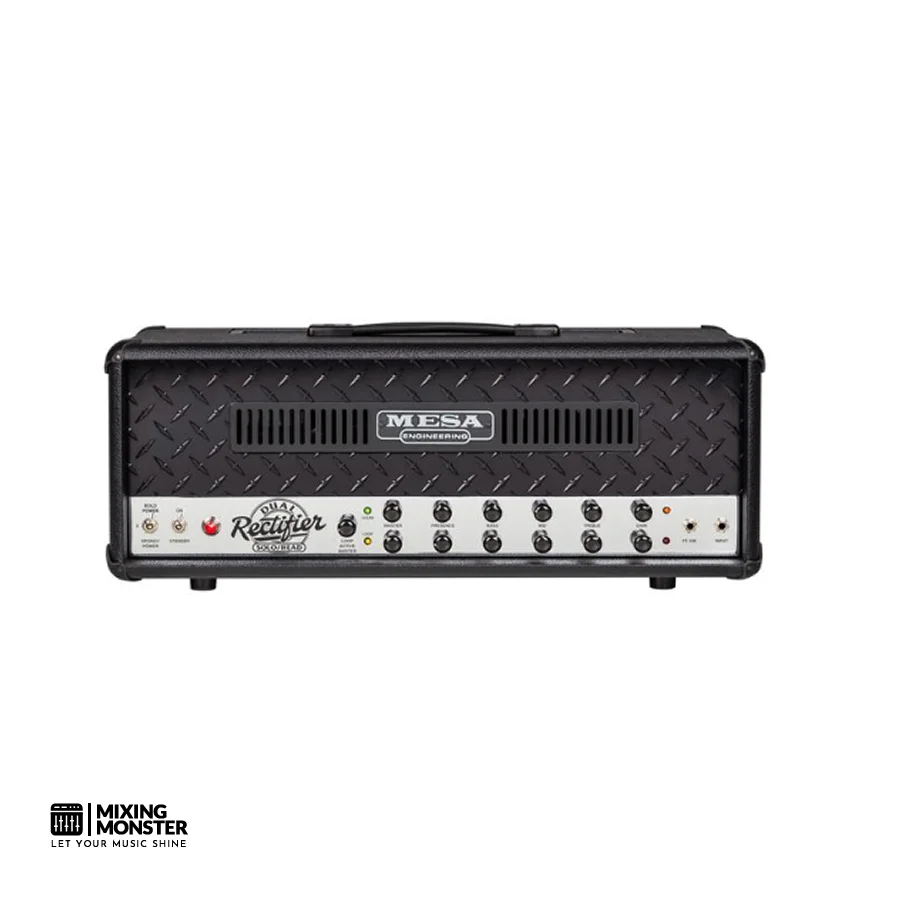
Overview:
The Mesa Boogie 90s Dual Rectifier stands as an iconic high-gain amp that really shaped the sound of ’90s and 2000s rock and metal. From what we’ve seen (and heard), it dishes out crushing distortion, thick lows, and mids that slice right through a band mix. If you’re after aggressive tones with some flexibility, it’s hard to beat.
Pros:
- Iconic high-gain tone with tight low-end
- Switchable rectifier modes (tube or silicon diode)
- Rugged build and stage-ready reliability
- Excellent channel separation
Cons:
- It can sound harsh if not dialed properly
- Heavy and bulky
- Best suited for high-gain genres
Unique Selling Point:
The Dual Rectifier‘s biggest asset is its selectable rectifier section—you can flip between vintage sag and modern tightness, so you’re never stuck with just one vibe.
Key Benefits:
- Extreme Versatility: Perfect for both rhythm chugs and soaring leads.
- Reliable Power: Built to withstand touring conditions.
- Customizable Feel: Switchable rectifier modes adapt to playing style.
Pricing:
| Average Price | ~ $3990 |
Review:
We’ve dragged the Mesa Boogie 90s Dual Rectifier onto countless stages and into all sorts of sessions—it’s still a benchmark for modern high-gain tone.
The three-channel layout covers everything from sparkling cleans to absolutely brutal distortion. That Rectifier switch? It’s a lifesaver, letting us toggle between tube sag for a vintage bounce or diode rectification for a tight, punchy attack—just what you want for metal riffing.
The tone is massive: deep lows, searing highs, and, even when you crank the gain, it somehow keeps its clarity. Honestly, it’s killer with extended-range guitars and drop tunings.
The Dual Rectifier can be a little unforgiving if you don’t dial it in just right, but when you nail that sweet spot, it’s pure sonic muscle. With its tough-as-nails build, it’s no wonder so many touring players swear by it.
#14 Soldano SLO 100 Classic
Best For Professional Guitarists Seeking Legendary High-Gain Tube Tone

Overview:
The Soldano SLO-100 Super Lead Overdrive delivers the iconic cascading-gain preamp sound that has been the secret weapon of many guitar heroes. It’s a 100-watt tube head with two channels, each with its own gain and master controls.
There’s a tube-buffered effects loop and variable impedance, allowing you to match it with virtually any cab. The military-grade parts give it the feel of being able to survive a tour bus crash. Blues, metal, classic rock—it all sounds killer through this thing, but man, that thick, saturated Soldano tone is what sets it apart.
Pros:
- Cascading-gain preamp gives you fat, harmonically rich overdrive
- You can crank the gain and still get a great tone at lower volumes
- Tube-buffered effects loop keeps your pedals sounding right
Cons:
- The price is, well, boutique-level
- Only two channels, so you don’t get as much flexibility as some modern amps
- It’s heavy—definitely not a grab-and-go head
Unique Selling Point:
The SLO-100‘s cascading-gain circuit is the heart of that “liquid lead” sound pros have chased for decades—tons of sustain, harmonics for days, and just the right amount of compression.
Key Benefits:
- Dynamic sensitivity lets you shape your tone just by changing how hard you play or rolling your guitar’s volume knob
- Variable slave output means you can record directly without fussing with mics or DI boxes
- Selectable impedance matching lets you use it with 4, 8, or 16-ohm cabs—super handy if you swap rigs a lot
Pricing:
| Average Price | ~ $3999 |
Review:
The Soldano SLO-100 Super Lead Overdrive is one of those amps you hear about in legends—and honestly, it lives up to the hype. The first time I fired it up, that tube warmth and syrupy overdrive were instantly noticeable. The cascading-gain preamp exudes sustain and harmonic richness, yet never becomes muddy or compressed.
I love how the amp responds to your touch. Play softly, and it sings; dig in, and it roars. The clean channel is more versatile than I expected—clean and sparkly at low gain, but push it and you get that classic crunch. It’s not just a one-trick pony.
The effects loop is a dream with pedals. Unlike some vintage amps, the tube-buffered design actually preserves your delays and reverbs with clarity and accuracy. The variable slave output came in clutch for direct recording, providing a strong, consistent signal without the need for additional gear.
Build quality is rock solid. The military-grade parts and heavy-duty chassis mean you don’t have to baby it, though you’ll probably curse its weight a bit on load-in days. Still, it feels like it’ll last forever.
Yeah, it’s expensive, but if you’re after that unmistakable Soldano sound, it’s hard to beat. The SLO-100 remains the standard for high-gain tube amps, and after using it, I completely understand why.
#15 Friedman BE-100 Deluxe
Best For High-Gain Rock And Metal Guitarists

Overview:
The Friedman BE-100 Deluxe is a favorite among rock and metal guitarists for good reason. This three-channel beast delivers that signature Friedman sound you’ve heard on a million records.
There’s a ton of attention to detail here—everything from the circuit design to the hardware feels premium. You get sparkling cleans, gnarly high-gain, and everything in between. It’s all hand-wired and packed with top-notch components, which is probably why it feels so substantial.
Pros:
- The high-gain channel is tight and focused—distortion that doesn’t get lost in the mix
- Three channels cover a huge range of tones
- Built like a tank, with reliable tube circuitry
- The effects loop works great with pedals
- Touch sensitivity is impressive across the board
Cons:
- It’s heavy—moving it isn’t much fun
- It’s pricey, so not everyone will be able to swing it
- You’ll need a proper cab to get the best out of it
- Loud enough to get you in trouble with the neighbors
- Lots of controls to learn—takes some time to really master
Unique Selling Point:
The BE-100 Deluxe nails that British-inspired high-gain sound—tons of clarity, even when you’re cranking the distortion.
Key Benefits:
- Tonal Versatility – Three channels let you transition from a glassy-clean sound to a modern-metal tone without switching amps or fiddling with pedals all night.
- Professional Build Quality – Hand-wired components and top-shelf parts ensure reliability for both stage and studio use.
- Studio Integration – The effects loop and balanced outputs make it easy to use in recording or live sound setups—no fuss.
Pricing:
| Average Price | ~ $3999 |
Review:
I’ve spent considerable time with the Friedman BE-100 Deluxe, and it consistently delivers. The clean channel is super articulate and has plenty of headroom before it starts to break up. If you push it, there’s this sweet compression that really flatters both chords and single notes.
Channel Two is where classic rock tones reside. It’s got that chewy overdrive and responds really well to your guitar’s volume knob or pickup switches. Roll back the volume, and it cleans up; dig in, and it gets punchy and compressed in a good way.
The third channel is the monster—high-gain, thick distortion that never gets muddy. I ran everything from single coils to hot humbuckers through it, and it stayed clear and punchy. Palm mutes are tight, and lead lines sing with sustain and overtones.
Every part of the amp feels premium. The point-to-point wiring, the heavy-duty chassis, the smooth controls—nothing feels cheap or flimsy. I’ve been using it for hours without encountering any issues.
The only real downside is the practical stuff. At 52 pounds, it’s a pain to haul around, and it’s way too loud for bedroom playing unless you’ve got an isolation cab; however, if you can handle the size and volume, the BE-100 Deluxe rewards you with some of the best tones available.
#16 Diezel Herbert MKIII
Best For Modern Metal And Rock Players

Overview:
We put the Diezel Herbert III through its paces, and honestly, it’s a monster for high-gain sounds while maintaining surprising clarity. German engineering truly shines here: 180 watts of tube power, three channels, and a mid-cut circuit paired with KT77s—the sound slices through any mix.
With MIDI connectivity and three effects loops, you can get pretty wild with your routing—great for both the studio and live gigs.
Pros:
- Super clear high-gain tones with barely any noise
- Three effects loops let you get creative with your signal chain
- MIDI lets you switch presets and control everything remotely
Cons:
- It’s heavy—50 pounds is no joke if you’re hauling gear
- Definitely not cheap, so it’s out of reach for a lot of players
- The controls are a bit intimidating at first and take some learning
Unique Selling Point:
The midcut circuit of the Herbert is really the star—it shapes frequencies just right for modern metal, clearing up mud but still keeping the lows punchy and the highs crisp.
Key Benefits:
- Versatile Channel Design – Three channels cover clean, crunch, and lead tones, working for everything from jazz to death metal if you want
- Professional Integration – MIDI and multiple effects loops make it easy to fit into complex rigs or recording setups
- German Engineering – Hand-wired build and top-notch parts, so it’ll take a beating on the road.
Pricing:
| Average Price | ~ $4299 |
Review:
The Herbert III really grabbed our attention right away—this thing’s built like a tank and sounds every bit as serious as it looks. The three channels make it crazy flexible, but honestly, we kept coming back to the lead channel for its sheer power.
Switching channels reveals very different personalities. The clean channel stays glassy and uncolored even when you crank it, and the crunch channel nails those classic rock vibes with definition. The lead channel? It just rips—tons of gain but still articulate.
The midcut circuit proved to be a lifesaver in our tests, allowing us to carve out space in the mix without compromising the guitar’s core tone. For metal, that’s huge. That feature alone makes the price more palatable.
At first, three effects loops seemed like overkill, but we quickly saw the point. We ran delays and reverbs in the serial loop, kept modulation in the parallel loops, and suddenly our pedalboard headaches vanished. No extra switchers needed.
We hooked up MIDI with the Herbert and it just worked—no lag, no drama. Channel and loop switching occur instantly, so you can rely on it for gigs where timing is crucial.
#17 Diezel VH4
Best For Legendary Boutique Tube Tone
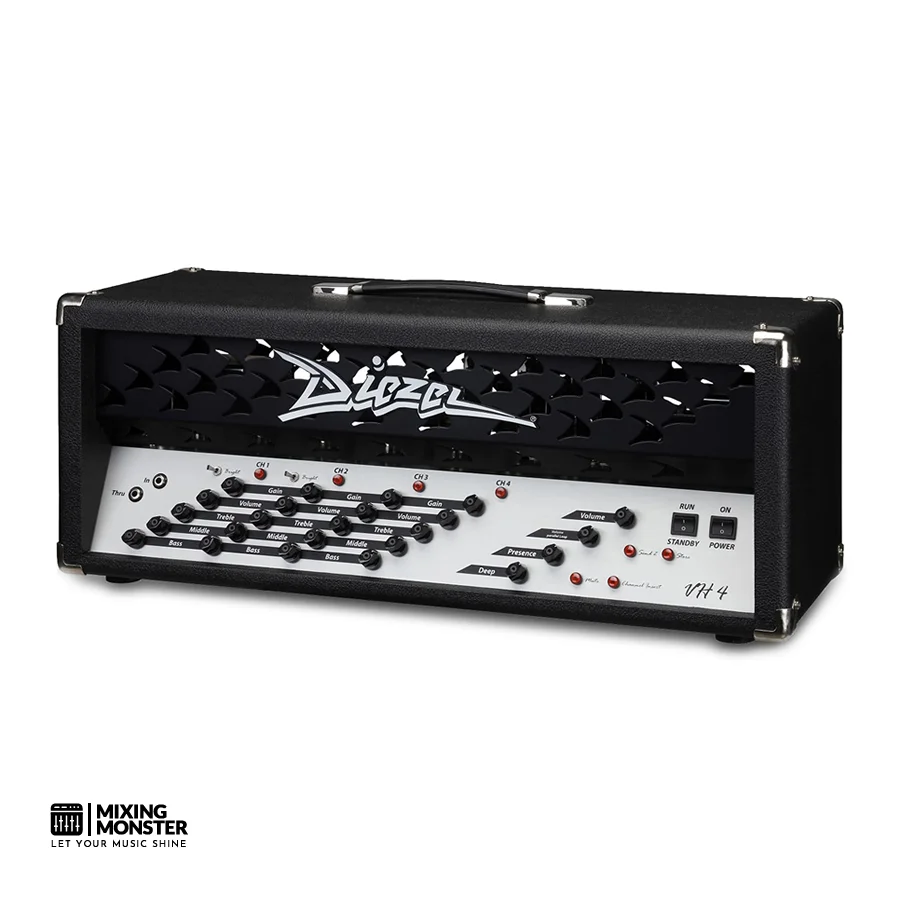
Overview:
The Diezel VH4 really put Diezel on the map. This 100-watt tube head gives you four totally separate channels with MIDI switching. We have parallel/series effects loops and global presence controls. Pro studios and touring players trust the VH4 for its consistent performance and huge palette of tones.
Pros:
- Rock-solid build, hand-wired, and uses premium parts.
- Four channels with their own voicing—go from sparkling clean to all-out high-gain
- MIDI lets you set up complex presets and switch on the fly
Cons:
- It’s expensive—most hobbyists will balk at the price.
- The control panel takes some getting used to if you want to unlock everything.
- At 40 pounds, it’s still a beast to lug around.
Unique Selling Point:
What really sets the VH4 apart? Four independent channels with their own inserts so that you can build totally different signal chains for each one. That’s rare.
Key Benefits:
- Channel Independence: Each channel comes with its own EQ, gain, and insert loop. You get four amps in one, basically.
- MIDI Control: Set up all your changes and recall them instantly—no more frantic pedal dancing.
- Professional Reliability: German-built quality and point-to-point wiring ensure it runs reliably night after night, even on grueling tours.
Pricing:
| Average Price | ~ $4499 |
Review:
The VH4 impressed us from the start. The construction is tough, and the front panel feels intuitive once you get the hang of it. Each channel reacts to your playing differently—Channel 1 is all about sparkling cleans, while Channel 4 brings crushing modern gain. The parallel effects loops keep your signal clean, allowing you to get creative with routing.
In the studio, the channel flexibility really stands out. The clean channel shines with single coils, but doesn’t get mushy with humbuckers. Channel 2 hits that sweet spot for crunchy rock without getting harsh.
When you want heavy, Channels 3 and 4 bring it. You get two flavors of saturation, both of which preserve the clarity of your notes. Even palm-muted riffs stay tight, even when you’re pushing the gain to the edge.
MIDI worked seamlessly with our board—channel changes were instant, no weird pops or lag. The dual master volumes let us balance tones for any room without fuss.
The build of the VH4 is as good as it gets. Inside, you’ll find handpicked tubes and military-grade parts. We didn’t encounter a single hiccup, even after numerous gigs and recording sessions.

2. What Is A Guitar Amp Head?
A guitar amp head is, simply put, the amplifier part of your rig—no built-in speakers. You’ll find the preamp, power amp, and all the controls in this one box.
You run a speaker cable from the head to a separate cabinet. That modular setup? It lets you mix and match speakers to suit your taste or the gig.
Key components include:
- Preamp section for shaping your tone
- Power amp for volume and punch
- Input/output jacks
- Knobs and switches for control
You can swap amp heads with different cabs, so dialing in the right sound for a venue or session is easy.
Heads come in all power ratings, ranging from 15 watts to 100+ watts. Higher wattage means more headroom before distortion occurs, but not everyone needs that much volume.
Common amp head types:
| Type | Characteristics |
|---|---|
| Tube | Warm, natural breakup |
| Solid-state | Clean, dependable |
| Hybrid | Mixes tube and solid-state tech |
Most heads offer you more than one channel, allowing you to switch between clean and dirty sounds with a footswitch. Super handy on stage.
Since the head and cab are separate, you can split the load, making hauling gear a bit less painful.
Pros usually go for amp heads because they want that versatility and the ability to tweak their setup for any situation.

3. Essential Accessories To Complement Your Guitar Amp Head
First off, get a speaker cab that matches your head’s impedance. If you mismatch, you risk damaging your gear or getting a poor sound quality.
Good cables matter. Invest in solid speaker and instrument cables—cheap ones can add noise or kill your tone.
A solid power conditioner is a must if you want to protect your amp from power spikes or dirty electricity. We wouldn’t skip this if you care about your gear lasting.
Essential accessories include:
| Accessory | Purpose |
|---|---|
| Speaker Cabinet | Projects sound, shapes tone |
| Speaker Cables | Connects head and cab |
| Power Conditioner | Guards against power issues |
| Footswitch | Switches channels/effects |
| Tube Set | Backup tubes for quick swaps |
We always keep spare tubes on hand for tube amplifiers. Tubes wear out, and you don’t want a gig or session ruined by a dead tube.
A good footswitch allows you to switch between channels or effects on the fly. For live shows, that’s a game changer—you can focus on playing, not fiddling with controls.
A sturdy amp stand helps too—raise your head, hear yourself better, and reach the controls without bending over.
Other handy extras:
- Attenuator for quiet practice
- Wireless system, if you want to roam the stage
- Rugged case for safe transport
- Multi-effects pedal for more sounds

4. Guitar Amp Head Buying Guide
Picking a guitar amp head isn’t just about power—it’s about matching your needs and style. Here’s what we look at:
Power Output comes first. Tube heads typically range from 15 to 100 watts or more. Solid-state can go higher, but if you’re playing at home, you don’t need all that muscle.
Tube vs. Solid-State is a big one. Tubes sound warmer and break up nicely, but they need more care. Solid-state amps are more reliable and low-maintenance.
| Feature | Tube | Solid-State |
|---|---|---|
| Tone | Warm, dynamic | Clean, steady |
| Maintenance | Needs attention | Pretty much worry-free |
| Weight | Usually heavy | Often lighter |
| Cost | More expensive | Budget-friendly |
Channels affect how flexible your amp is. Some heads are single-channel for pure tone, while others offer multiple channels with footswitches, allowing you to switch between clean and dirty tones instantly.
Built-in Effects like reverb or delay are convenient, but sometimes dedicated pedals sound better. It’s a tradeoff.
Speaker Outputs need to match your cab’s specs. Double-check impedance and output options if you plan to use different cabs.
Budget is always a factor. Figure out what matters most for your playing and spend where it counts, instead of blowing cash on stuff you’ll never use.
5. Finding Your Perfect Guitar Amp Head: Key Takeaways
Start by thinking about your musical style and venue requirements. Every genre seems to crave its own blend of tone and power, so you’ll want to match your amp to the sounds you’re chasing and the places you play.
Tube amp heads give you that sweet, natural compression and a bit of harmonic magic. They shine for blues, rock, and metal, but be ready for some upkeep from time to time.
Solid-state options stick around for the long haul and deliver a consistent sound. If you’re after crisp cleans or modern metal, these are tough to beat.
Hybrid designs mix tube preamps with solid-state power sections. Honestly, these can hit a nice balance—warmth without the hassle (well, less hassle, at least).
| Power Rating | Best For |
|---|---|
| 5-15 watts | Home practice, small venues |
| 30-50 watts | Medium venues, recording |
| 100+ watts | Large venues, outdoor shows |
Try amp heads with your own guitar and pedals whenever you can. Those in-store demos just don’t tell the whole story, do they?
Budget matters, but don’t forget the long game. Tubes need replacing, and a little maintenance here and there will sneak up on your wallet.
Single-channel heads fit folks who rely on pedals for shaping their tone. Multi-channel options are a better match if you want to switch sounds right from the amp.
Look for user reviews from players who play the way you do. Specs might look good on paper, but real-world feedback is worth its weight in gold.
Brand reputation really does make a difference—reliability, resale value, and support tend to be better with the classic names.
Don’t underestimate transport needs. Lugging a heavy head around gets old fast, especially if you’re gigging a lot.
Our Top Picks For The Best Guitar Amp Heads
Best Budget Guitar Amp Heads
- Hughes & Kettner TubeMeister Deluxe 20
- Orange Dual Terror
- ENGL E633 Fireball 25
Best Midrange Guitar Amp Heads
- Vox AC30H
- Hughes & Kettner Triamp Mark 3
- ENGL Fireball 100 E635
- Peavey 6505 II
Best High-End Guitar Amp Heads
- Marshall 1959 HW
- EVH 5150 III 100S
- Orange Rockerverb 100 MKIII
- ENGL Savage 120 E-610 MKII
Best Iconic Guitar Amp Heads
- Mesa Boogie IIC+ HRG
- Mesa Boogie 90s Dual Rectifier
- Soldano SLO 100 Classic
- Friedman BE-100 Deluxe
- Diezel Herbert MKIII
- Diezel VH4

FAQ
1) What are the most cost-effective guitar amp heads available today?
The Orange Dual Terror really stands out for value, coming in under $1000 with its compact design.
The Hughes & Kettner TubeMeister Deluxe 20 delivers genuine tube flavor for around $900, providing authentic high-gain.
2) Which guitar amp heads are considered the best for achieving a metal tone?
The Peavey 6505 remains the go-to choice for modern metal, with its high-gain channel truly impressive. Mesa Boogie’s Dual Rectifier? It’s legendary for its bone-shaking low end and tight, punchy chugs.
ENGL’s Fireball nails that precise, multi-stage gain thing. EVH 5150 III heads deliver Eddie’s iconic sound with added flexibility.
Orange Rockerverb amps deliver that distinctive British tone, combining grit and clarity.
3) What are the top-rated tube amp heads for guitarists as of recent years?
The Marshall Plexi Super Lead 1959HW reissue brings back classic rock vibes with its hand-wired guts. Vox AC30 heads deliver those jangly British Invasion sounds thanks to their EL84 tubes. Friedman’s BE-100 is a modern high-gain beast.
4) What’s the difference between a guitar amp head and a combo amp?
A guitar amp head is the top section of an amplifier that contains the electronics and tone-shaping controls but doesn’t include speakers. You’ll need to connect it to a separate speaker cabinet to produce sound. A combo amp, on the other hand, combines the amp head and speakers in one unit, making it more portable but often less flexible for tone customization and stage setups.
5) How do I choose the best guitar amp for home use?
For apartments or late-night jamming, 1-5 watt tube heads keep the volume down while still providing that classic tube breakup. Orange Dual Terror and Hughes & Kettner TubeMeister Deluxe 20 both fit nicely into small spaces.
Look for heads with built-in attenuation, like the Marshall DSL1HR, if you want to keep things neighbor-friendly. Modeling amps with headphone outs are a lifesaver for silent practice.
Speaker efficiency can make a light amp sound significantly larger than you’d expect. Pair a low-wattage head with a good 12-inch speaker, and you’ll achieve great home tones without disturbing your neighbors.
6) What characteristics define the greatest guitar amps throughout history?
Legendary amps typically feature simple, yet practical circuits that ultimately shape entire genres. Marshall Plexi heads fueled the British rock explosion in the ’60s. Then, in the ’90s, Mesa Boogie Dual Rectifiers took over the alternative and nu-metal scenes.
Vox AC30 gave The Beatles and R.E.M. that unmistakable chiming 12-string sound. These amps stand out for their unique tones, which have become closely tied to specific musical eras—and, honestly, they continue to influence the design of modern amps.

